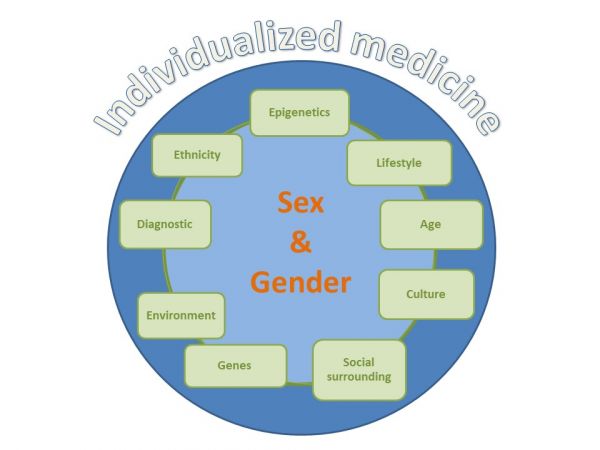Individualized medicine/Expert
For a long time, the strategy of "one size fits all" was applied in medicine, which is now regarded as inadequate. At present, it is necessary to consider integrative factors such as age or ethnicity in research and practice and to expand treatment strategies to include these aspects. Ideally, the care of each individual should be provided by means of targeted examination and treatment options. Not only personal circumstances on a socio-psychological level play a role (e.g. social environment, lifestyle or cultural conditions), but also the inclusion of modern biomedical technologies (e.g. newer examination methods on a molecular level). With reference to both socio-psychological and biological influencing factors, individualized care should be considered from a sex and gender medical perspective. Individual components of individualized medicine are shown in Figure 1.
Figure 1: Building blocks of individualized medicine. Modified according to: Harreiter et al. (2016).
The aim is not only to improve treatment strategies, but also to prevent diseases and maintain quality of life. Adequate implementation of individualized care requires not only certain political and legal structures, but also vital aspects such as infrastructural conditions and sufficient financial and personnel resources. In order to be able to manage and control all medical information, a certain standard of data protection and processing must also be ensured (see Figure 2).
Figure 2: Requirements of individualized medicine. Modified by: Harreiter et al. (2016).
In order to ensure the highest possible quality of treatment for each individual, a fundamental restructuring of the health care system is necessary. At present, there are not enough capacities and organizational structures for the adequate implementation of individualized measures. [1]
You can find out more about this topic in Module 1: Sex and Gender in Medicine.
Literature
License
This article is published under the Creative Commons License. The full license content can be retrieved here: https://creativecommons.org/licenses/by/3.0/legalcode
Autoren
Last changed: 2021-02-19 21:58:14


